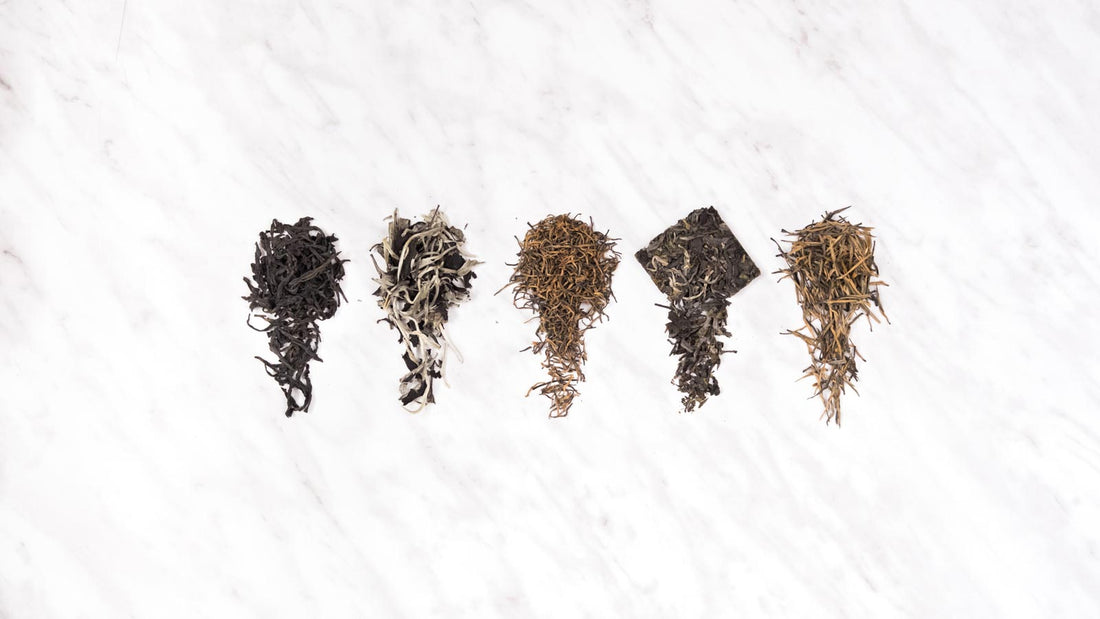For our Vol. 3 Exploration Kit, we wanted to take you on a journey to two regions in China, Yunnan and Fujian, where you'll get to taste and compare a black tea from each area. In addition, we thought it'd be fun to explore a tea that may be less common to new tea drinkers. Check out our tea stories below to learn more about what's in your cup.
Sheng (raw) Pu’er
Moonlight White
Yunnan Black (Dian Hong)
Jin Jun Mei
Qi Lan
Here's a map to give you an idea of the journey this Exploration Kit will take you. Locations are approximate and intended to serve as a visual guide only.
Sheng (raw) Pu’er

Dark Tea
Spring 2020
Yongde, Yunnan, China
Pu'er is probably one of the trickiest tea type to break into if you have never tried it, especially the ripe (shu/熟) version that’s full of earthy and musky tones. Yet it is an interesting tea type as it changes continuously as it ages.
Notes: Vegetal, Floral
Gongfu:
4g | 100ml | 90c | Rinse – 10-15 sec
Western:
2g | 250ml | 90c | 3 min
This raw (sheng/生) pu’er is grown and produced in Yongde, one of the tea districts in Lincang. The beauty of this tea is that it is grown among ancient forest situated within a National Natural Reserve. Maybe that’s why there’s a hint of pristine forest in the brew. As it’s a young raw pu’er, the tea is vibrant with astringency that changes into lingering sweetness.
The story of Pu’er
Yunnan is believed to be the birthplace of tea with ancient tea trees dated back hundreds and thousands of years. Pu’er is undisputable one of oldest (if not THE oldest) tea, so old that it’s hard to pinpoint the exact time (popular reference is 2,000 years ago in Eastern Han Dynasty). Records showed that by the Tang Dynasty (AD618-907), Pu’er tea was already being traded outside of Yunnan in compressed bricks, not dissimilar to the current format.
Pu’er tea is produced by ethnic minorities in a unique processing method which allows the tea to continue to age and improve. Good pu’er could become outstanding if stored in the right conditions. Flavor develops and changes drastically over time with more complexity that people are willing to pay high prices for aged ones.
It is made with native big leave varietal in two distinctive styles - raw (sheng) and ripe (shu). Before the 70’s, raw was the only style. Since the aging process takes anywhere between 10-50 years, due to popular demand by the 70’s, tea producers invented the ripe style to speed up the aging. Both styles are produced exactly the same but the ripe style goes through an additional artificial fermentation process, wet-piling, for 45-60 days.
With this artificial fermentation, ripe pu’er would develop an earthy flavor with a rich mouthful instantly. Having said that, many people enjoy drinking a young raw pu’er for its crispness, just like ours.
Moonlight White

White Tea
Spring 2020
Simao, Yunnan, China
Moonlight White, or Moonlight Beauty (月光美人), a white tea differed from the traditional definition in many ways, even some experts were debating whether it should be classified as Pu’er or White tea. We voted for the white tea camp. What about you?
Notes: Sweet, Floral
Gongfu:
4g | 100ml | 90c | 25-30 sec
Western:
2g | 250ml | 90c | 2-3min
This Moonlight White is harvested and processed by hand. But instead of the usual sun withering technique in Fujian, it’s processed indoor. The longer withering leads to a slightly longer oxidation, which allows the development of a thicker and more full body liquor.
The story of Moonlight White
Pu’er tea has always been the star from Yunnan, but Moonlight White has been scooting into the limelight in recent years. Records showed that the Da Bai (Big White大白) tea plants were planted in Jinggu, Yunnan 160 years ago, and was once a tribute tea in the Qing Dynasty.
There are many versions on how the poetic names Moonlight White or Moonlight Beauty came about. Some said because the tea is picked and withered at night under the moon by beautiful tea ladies. Other said that because the black and white tea leaves look like crescent moon.
And because of the tea varietal, Moonlight White’s flavor is slightly more prominent with a richer mouthfeel. Not to mention the more forgiving brewing nature. A soothing tea that can be brewed multiple times, one can enjoy it until the moon comes out.
Yunnan Black (Dian Hong)

滇紅
Black Tea
In Vol 3: Autumn 2020
Currently Selling: Spring 2022
Feng Qing, Yunnan, China
Another newcomer to the long tea history of Yunnan. Dian Hong’s vibrancy and sweetness has easily captured the crowds, even with people who don’t normally enjoy black tea might change their mind.
Notes: Floral, Sweet
Gongfu:
4g | 100ml | 90c | 10-15 sec
Western:
2g | 250ml | 90c | 2-3 min
This Dian Hong is hand-picked in the autumn of 2020. As it’s processed by hand, the 1 bud and 1 – 2 leaves structured remained mostly intact beautifully. The dry leaves give off an inviting honey note. The tea is brewed to a golden amber color with very little astringency, making it another great black tea to enjoy straight.
The story of Dian Hong
Unlike many native Yunnan teas that are deep rooted with the ethnic minorities, Dian Hong is a tea initiated by the Han (漢) people.
During the first Sino-Japan war, tea production in traditional black tea regions in East China were put to a halt. To maintain the export revenue, China Tea Trade Company sent tea experts Mr Feng Shaoqiu (馮紹裘) and Mr Zheng Hechun鄭鶴春 to Yunnan in search of possible black tea plantation in 1938. They have quickly identified the Da Ye tea plants in Feng Qing 鳳慶to be most suitable. Dian Hong was successfully “invented” and produced, then promptly shipped to the UK via Hong Kong the next year. During Queen Elizabeth II’s visit to Yunnan in 1986, Dian Hong was presented to her as a welcome gift. In 2014, Dian Hong production was chosen by the Chinese Government as one of the National Intangible Cultural Heritage of China.
Many of the famous Chinese black teas, such as Keemun, and Zhen Shan Xiao Zhong are produced with the smaller leaf varietal, Dian Hong’s native big leaf varietal has certainly broadened the Chinese black tea spectrum. The sweet dry leaves often contained some lovely golden tips. And it does not disappoint when brewed - a golden orange velvety and sweet liquor that's pleasing both to the eyes and the palate.
Jin Jun Mei


金駿眉
Black Tea
In Vol 3: Spring 2020
Currently Selling: Spring 2022
Tong Mu Guan, Fujian, China
Who can resist another delicious black tea that’s meant to be enjoyed straight? Jin Jun Mei is probably the youngest tea invention for Chinese black tea. Created in 2005, it was made with the intention to fill the missing gap of fine black tea.
Notes: Grain, Sweet
Gongfu:
4g | 100ml | 90c | 3-5 sec
Western:
2g | 250ml | 90c | 2-3 min
This tea is harvest and produced in Spring 2020 in Tong Mu Guan, the birthplace of black tea. Made up of golden buds, it yields a full body tea that’s malty, sweet with a slight touch of smoke. If you want to experience the lingering sweetness from tea (hui gan 回甘), you would like to reach for this.
The story of Jin Jun Mei
Black tea had not always been opular in China. In fact, most black tea was produced as an export commodity in the past. That is what makes Jin Jun Mei special. As it’s invented fairly recently in 2005, a time that marked the shifts in domestic tea preference as well as economic conditions.
Jin Jun Mei was set out to be created as a fine tea from the very beginning. Its creator, Mr Jiang Yuanxun江元勳, is the 24th generation owner of Zhen Shan Tong (正山堂) that specialised in producing Zhen Shan Xiao Zhong for more than 400 years. His goal was to create a tea that could elevate black tea quality to attract tea lovers into black tea.
Unlike regular black tea, Jin Jun Mei is made purely with the buds. This resulted in a beautiful golden amber liquor with nectar sweetness and richness of a black tea, but none of the bitterness or astringency.
Qi Lan

奇蘭
Oolong Tea
In Vol 3: Spring 2020
Currently Selling: Spring 2022
Wuyishan, Fujian, China
Classified as an oolong, Wuyi oolong is often referred as Wuyi cliff tea or rock tea (武夷岩茶) because of its distinctive “cliffy” mineral characteristic. It’s hard to explain in words, but a search online for pictures of the majestic landforms of Wuyishan (Wuyi Mountain 武夷山) would surely give you some ideas.
Notes: Floral, Mineral
Gongfu:
4g | 100ml | 98c | 10-15 sec
Western:
2.5g | 250ml | 98c | 2-3 min
This spring harvested Qi Lan is light roasted, which gives off a natural sweetness and magnolia aroma with a mineral backbone. We found this tea a wonderful entry into cliff tea, before venturing into the ones that are more robust in comparison.
The story of Qi Lan
Qi Lan is a relatively new varietal within Wuyi cliff tea family as it’s only migrated to Wuyishan in the 90s. Luckily it adapted to the Wuyishan terroir and the proprietary tea processing method exceptionally well, it became one of the tea lovers’ favorites. Having said that, Wuyi tea has a very long history of fame since the Tang Dynasty and earned a special trade name Bohea in the English world in the 17th century.
Wuyi Mountain consisted of 36 peaks and 99 cliffs. With tea plantations growing among cliffs and rocks, an unique terroir that is hard to replicate, Wuyi cliff tea is prized for its intoxicated floral and fruity notes, along with a mineral-y rock flavor (岩骨花香). People often referred this rock flavor as the essence of cliff (Yan Yun岩韵). Even Emperor Qian Long (Yes him again from Vol. 2) wrote a poem after savouring a Big Red Robe cliff tea.
It is worth noting that the closer to the central of Wuyi Mountain the tea is harvested from, the stronger yan yun and rare the tea is. That’s why the price range is ridiculously wide even for the same type of cliff tea. But once you tasted the difference, all is justified.

